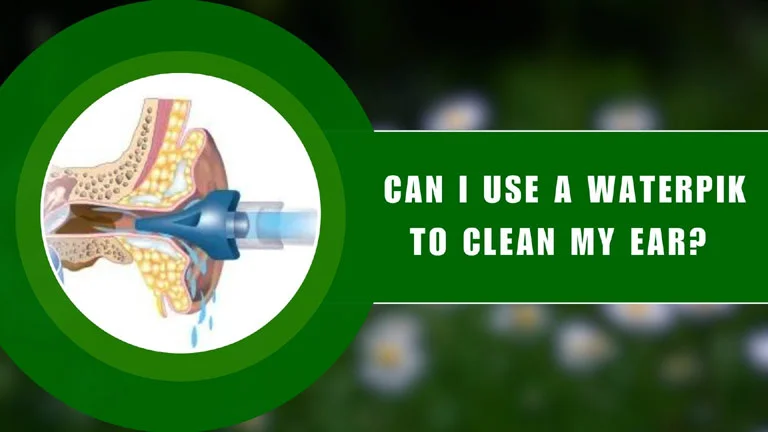Can i use a waterpik to clean my ear? it is not safe to use a Waterpik to clean your ears. The pressure generated by water picking even at low can damage the eardrum permanently and force wax further into the eardrum.
The ear is something we don’t realize how sensitive and important to us. Waterpik may appear to be a perfect DIY, but it is not. Engaging and spending money on ear maintenance is a must, so have it done by specialists for improved ear health.
Delicate Nature of Ear Health
The ear is a complex and delicate organ The ear canal is lined with sensitive skin, and its structure includes the eardrum, tiny hair cells, and glands. The powerful stream of waterpik can be too forceful for the delicate structures of the ear.
Waterpik can cause damage to the eardrum or push earwax deeper into the ear. Maintain good ear hygiene, seek professional assistance when needed, and protect the ears from excessive noise.
Can I Use A Waterpik To Clean My Ear?
Ear cleaning using a Waterpik or similar device is not suggested because of the risk of injury, infection, and harm to the delicate components of the ear. Do not use any product that sprays high-pressure water straight into your ears (such as a WaterPik); doing so threatens to perforate your eardrums.
There is a high possibility that bacteria will grow and spread inside your ears and cause infection due to water in your ears. These infections may heal, but your hearing ability may not.
High-pressure water can rupture the tympanic membrane in your ear, turning you deaf for life. Since the ear regulates your bodily equilibrium, pouring water into your ears is dangerous. Water can also harm the fluid within the ears. If you use them, you may get ear discomfort, swelling, and tinnitus.
Ear Hygiene Do’s and Don’ts
Do’s:
- Clean the outside of your ear (visible portion), including the pinna, using a soft, wet cloth.
- After bathing or swimming, tilt your head to each side to drain water from the ear canal.
- wear earplugs or earmuffs to reduce the risk of noise-induced hearing loss in concerts.
- consult with an audiologist or hearing healthcare professional regularly to ensure proper care and improvements.
Don’ts:
- Don’t Use ear candles to remove earwax
- Don’t clean your ear canals with cotton buds
- Don’t Aggressively scrub the outside of your ears
- Do not ignore persistent pain, drainage, or hearing loss.
Safe Ear Cleaning Practices: Can I Use A Waterpik To Clean My Ear?
Potential Risks of Using a Waterpik for Ear Cleaning
- The pressure of the water stream from a Waterpik can damage the ear canal, eardrum, or other delicate structures within the ear.
- Waterpik can push earwax deeper into the ear canal, potentially causing impaction or blockage.
- Providing a favorable environment for bacterial or fungal development, potentially resulting in ear infections.
Self-cleaning mechanism
Ears possess a self-cleaning mechanism that eliminates extra earwax and debris naturally. Inserting objects, like a Waterpik, into the ear canal can interrupt this natural process and potentially cause injury.
Importance of Ear Care
By practicing good ear care, you are protecting your hearing abilities and preventing hearing loss caused by various factors, including noise exposure and aging. By practicing regular ear care, you can parotitis media (middle ear infection) or otitis externa (swimmer’s ear), discomfort, and temporary hearing loss.
Maintaining inner ear structures through good ear care helps us stay balanced and avoid problems like dizziness or vertigo. Earwax (cerumen) is a natural substance produced by the ear to protect the ear canal. Taking care of our ears is essential for preserving our ability to hear and maintaining balance
Wrap up
Can I use a Waterpik to clean my ear? Waterpiks and other oral irrigation devices are not intended to clean the ears. Using them to clean your ears can be dangerous because it can give injury or damage to the delicate structures of your ears.
Before attempting to remove compacted cerumen with any home treatments, including a Waterpik or other jet irrigator, see your doctor. According to your particular medical history, your doctor will perform a physical inspection of your ear and give suggestions for the best technique for wax removal.
FAQ
Warm water helps soften earwax since it is water soluble. You may do this in the shower with warm water. Tilt your head to one side and pour some water into your ear canal, then tilt the opposite way so the water drains.
Soak a cotton ball in plain water, a basic saline solution, or hydrogen peroxide, and drip a few drops into the ear with your head inclined so the entrance of the ear points up. Let gravity draw the fluid down through the wax for a minute by holding it in that place.
A Waterpik can be used for sinus cleaning, and removing plaque, debris, and bacteria from the teeth and gums.
Excess wax can be removed by using a curet, a tiny, curved instrument, or suction procedures. Your doctor can also use a syringe loaded with warm water and saline or diluted hydrogen peroxide to wash out the wax.
Water can often persist in your ear for many hours to 1-2 days. It is dependent on the individual, their ear anatomy, and earwax production. It will also depend on the intensity and type of water exercise.

